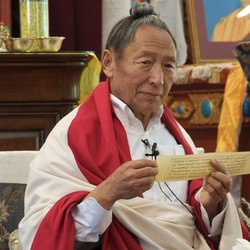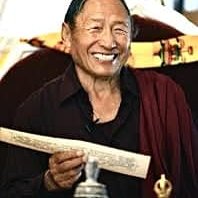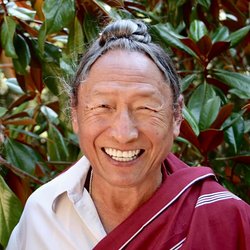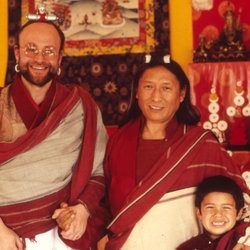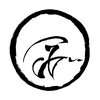Lama Tharchin Tsédrüp Rinpoche (sNgags ’chang bLa ma mThar phyin tshe grub / སྔགས་འཆང་བླ་མ་མཐར་ཕྱིན་ཚི་གྲུབ་/ 1936-2013) the tenth lineage holder of the Repkong Ngakpas. The photograph above shows his uncle Lama Sherab Dorje Rinpoche.
Lama Tharchin Tsédrüp Rinpoche was a good friend of Ngak’chang Rinpoche and Khandro Déchen. He once came to Wales and stayed with them in Penarth.
Whilst staying with them he gave a day’s teaching on the Seven Line Song of Guru Rinpoche (tsig-dun sol-dep / tshig bDun gSol 'debs / ཚིག་བདུན་གསོལ་འདེབས་).
Ngak’chang Rinpoche recounts from this time: “There was a story which my friend Tharchin Rinpoche used to tell about this father Lama Shérab Dorje Rinpoche.
When giving Dzogchen teaching on the way of approaching strong emotions — he would speak very simply.
He would say: ‘Anger is like raw meat. There’s nothing wrong with raw meat.
Raw meat is a good basis for a meal — but you have to grill it immediately. If you grill it immediately, then it’s delicious.
The only problem that arises with raw meat, is when you leave it too long. If you don’t grill it in good time, it begins to change colour. Then it begins to stink. Then the stench becomes worse — and finally , maggots start appearing in it. The the longer you leave it, the worse the situation becomes.’
And so, in this fashion, he would continue the analogy of grilling meat. He would say that in approaches other than Dzogchen the afflictive emotions are seen as negative — and so there are ways of dealing with them
In Sutrayana you renounce the emotions.
In the Outer Tantras you purify the emotions.
In Mahayoga and Anuyoga you transform the emotions.
According to Dzogchen however — precisely when the emotion is fresh, you allow it to arise and fully develop. Then immediately you stare into it. You gaze. You sit with the anger without trying to change anything.
You don’t reject to the anger. Nothing needs to be transformed. Nothing needs to be purified. You simply sit with the anger — and then this quality of anger is realised as opposite of ignorance. This energy of anger doesn’t allow you be drowsily distracted. It is completely wakeful.
When you gaze directly at anger, you recognise its essence. The anger is liberated. This essence of anger is Mirror Wisdom. Mind becomes as wakeful and clear as a mirror.
The anger cannot continue. When you relax and simply sit with anger, the anger disappears before your eyes — and what remains is clear, wakeful mind. This is what Dzogchen means.”
Tharchin Rinpoche was the tenth lineage holder of the Repkong Ngakpas. This family-based gö kar chang lo (gos dKar lCang lo / གོས་དཀར་ལྕང་ལོ) lineage was the largest such community in Tibet. Lama Tharchin Rinpoche was trained in Düd‘jom Rinpoche's Gompa, engaged in 5 years of solitary retreat — and then completed a 3 year retreat under the supervision of Kyabjé Düd’jom Rinpoche.
In addition to Dudjom Rinpoche, his main teachers have been his father ‘öng-tsang Chhi‘mèd Dorje, Lama Shérab Dorje Rinpoche, and Kyabjé Dung-sré Thrin-lé Norbu Rinpoche. He also received teachings from Shéchen Kongtrül Pema Dri’mèd Legpa’i Lodrö.
Rinpoche left Tibet on foot with his family in 1960. He lived in Orissa, India and Kathmandu, Nepal before going to America in 1984. While in America, Kyabjé Düd’jom Rinpoche asked Lama Tharchin Rinpoche to teach Vajrayana.
He was a family ngakpa with two sons — one of whom, Dung-sré A’gyür Rinpoche, is a close friend of Ngak’chang Rinpoche and Khandro Déchen. We learned from A’gyür Rinpoche that his father knew that Ngak’chang Rinpoche was a gTértön long before it became publicly known. He said the Kyabjé Dung-sré Thrin-lé Norbu Rinpoche was also aware of this from his own father Kyabjé Düd’jom Rinpoche Jig’drèl Yeshé Dorje.
Ngak’chang Rinpoche said:
“I spent many happy times with my friend Lama Tharchin Rinpoche at his Vajrayana Foundation Retreat Centre Pema ’ö-Sèl Ling in the Santa Cruz Mountains.
Lama Tharchin Rinpoche was a very good and dear friend to me and to Khandro Déchen. I have so many marvellous memories of joyful times within Tharchin Rinpoche: working on the clay form of the Guru Rinpoche statue; teaching at local bookstores with him; practising Tsog’khorlo with him and his students; engaging in Vajrayana Crafts; telling Lineage stories; making momos; and, telling jokes. Tharchin Rinpoche had a huge sense of humour.”
Tharchin Rinpoche was acknowledged for his vast knowledge of Himalayan Vajrayana arts, painting, sculpture, music, and dance. Ngak’chang Rinpoche worked with him in making the statue of Guru Rinpoche which presides over the shrineroom at Pema ’ö-Sèl Ling.

This photograph was taken outside the ‘Norwegian Church’ in the marina area of Cardiff, on the occasion of Tharchin Rinpoche’s visit to the Bay Area of South Glamorgan.

